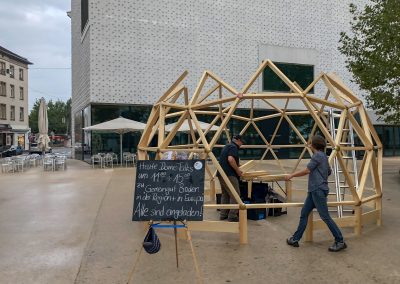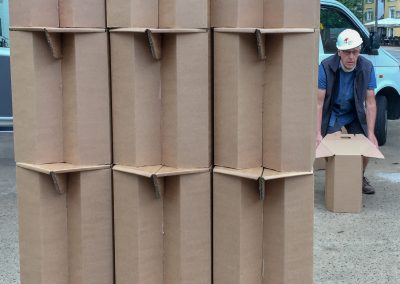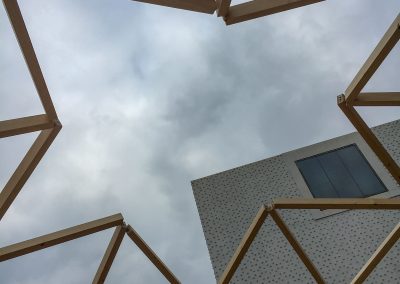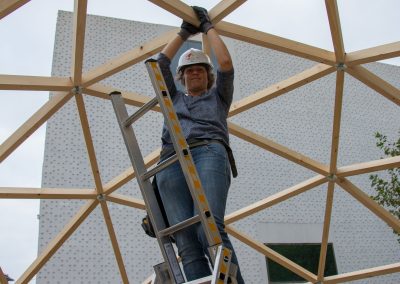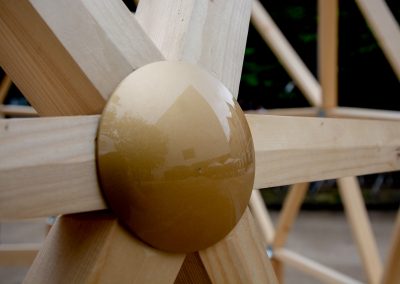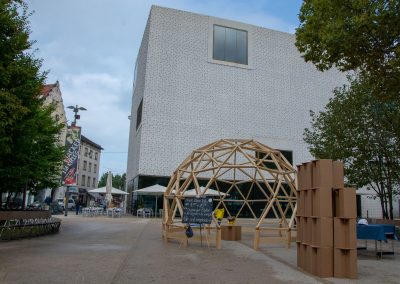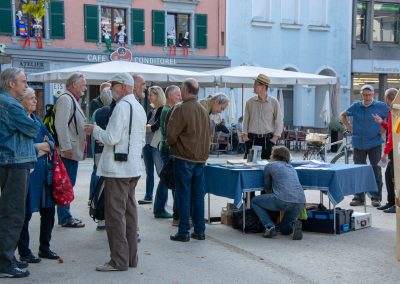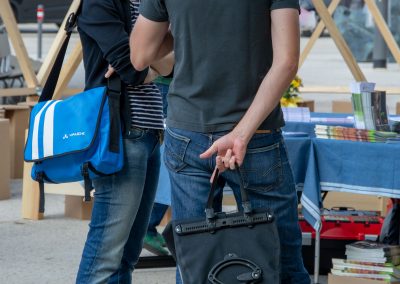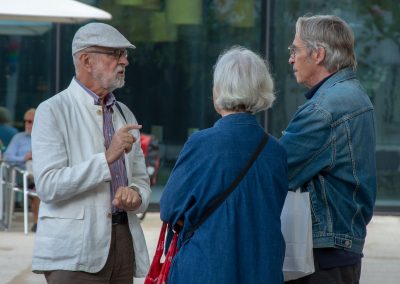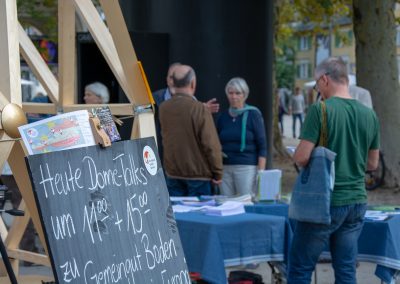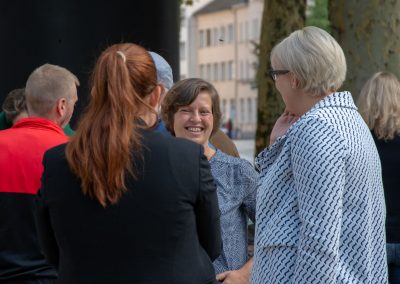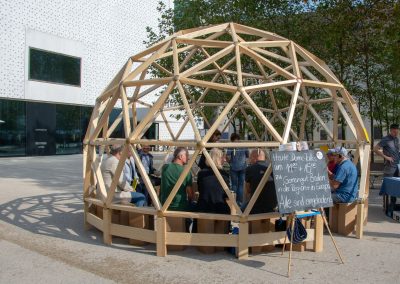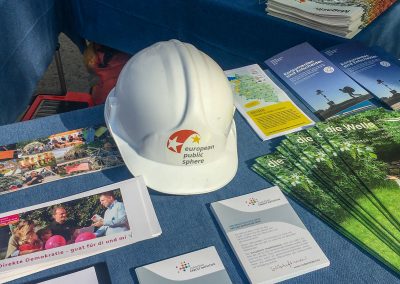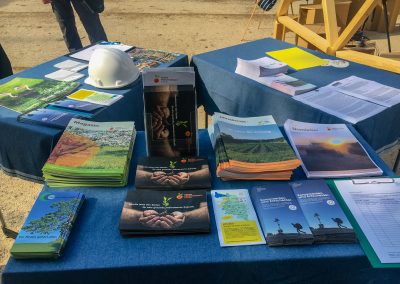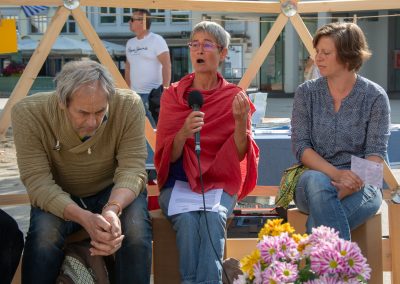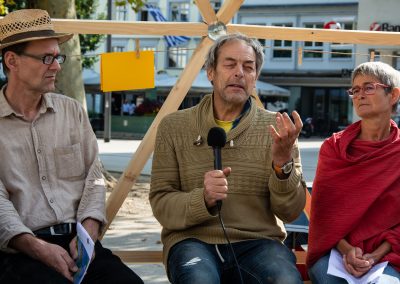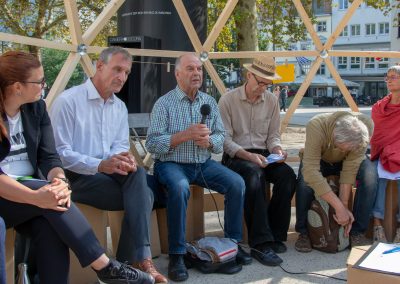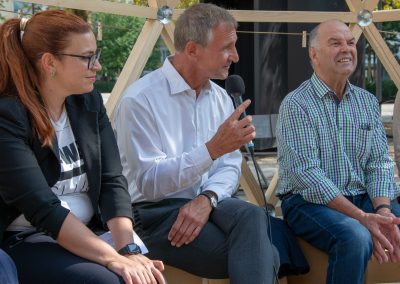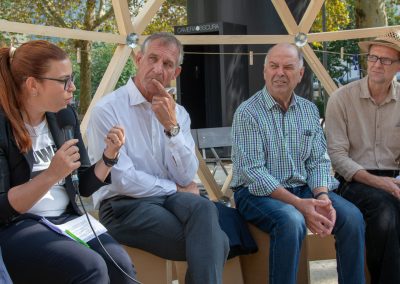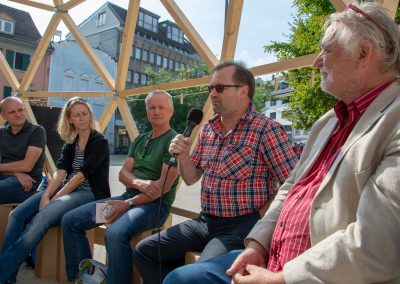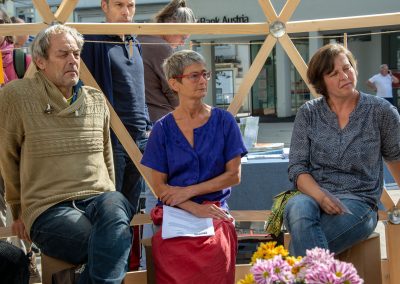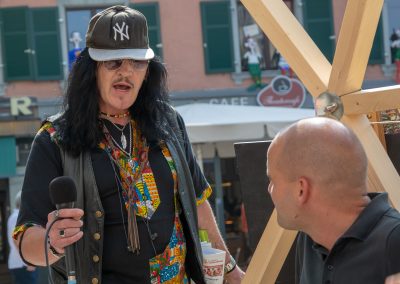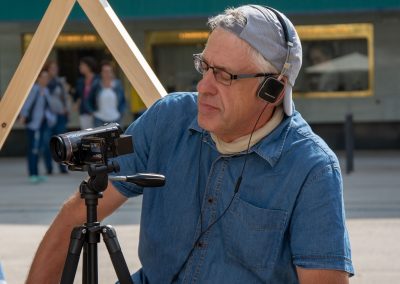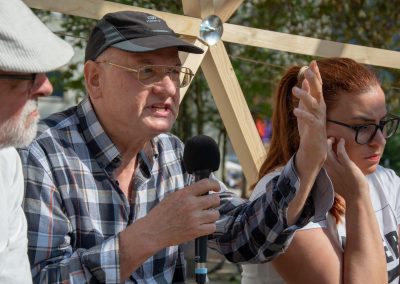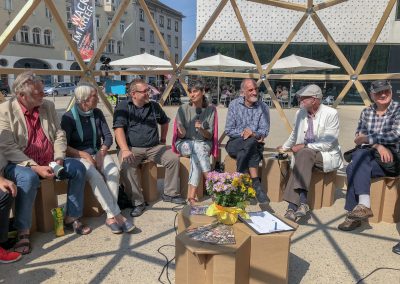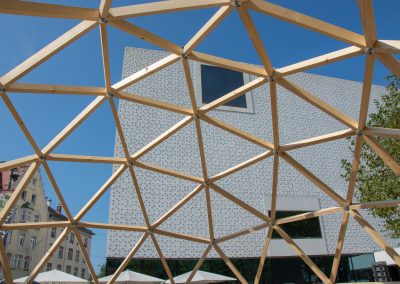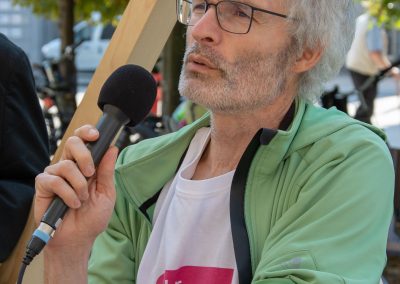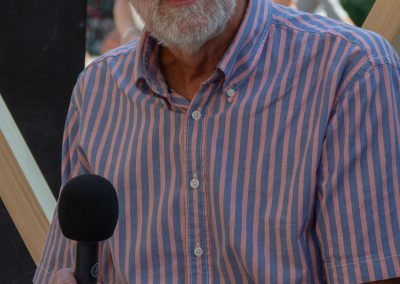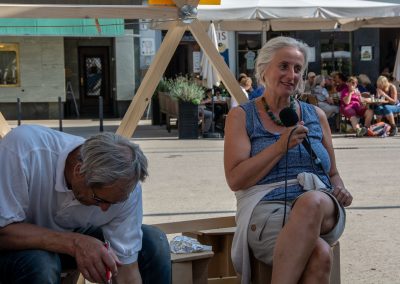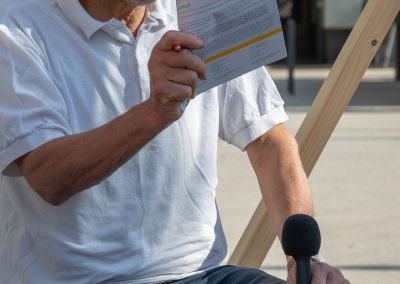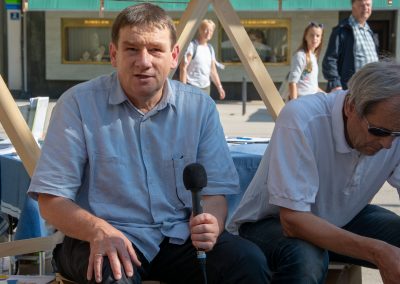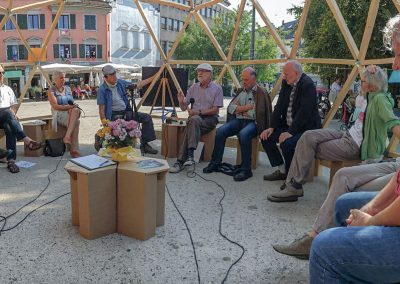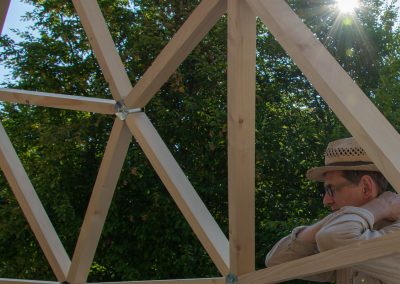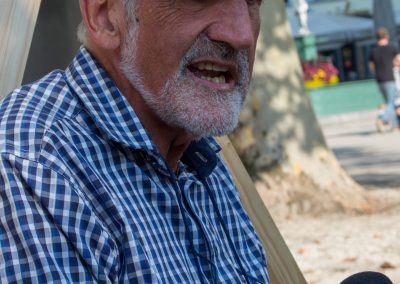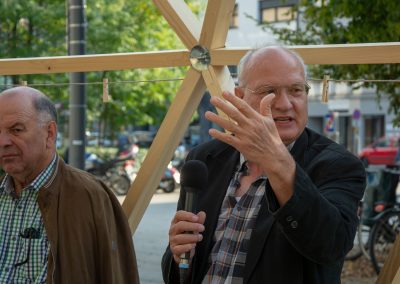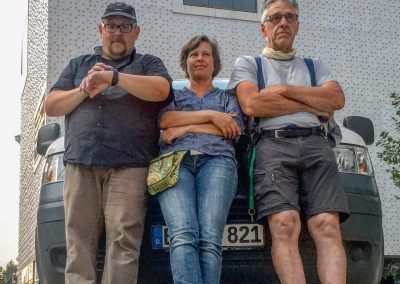Common Property “Land” – A Dome-Day in the Border Triangle DE-AT-CH
Early in the morning, we erected the dome in Bregenz at the Kornmarktplatz, directly next to the Vorarlberg Museum – the “most beautiful place in the country”, as the mayor of Bregenz, Markus Linhart, said in his welcoming address. This time we had not only invited to our usual Dome Talks but had also described the whole event as a “theme and information day” and advertised it in the region. Even the information table with its colorful flyers and brochures showed the variety of initiatives active in this field. Hence a lively exchange between the participants and passers-by arose – even before we met under the dome.

In the discussion, the breadth of the topic became immediately clear: In addition to questions on alternative forms of housing and communal building, political design fields such as spatial and transport planning and urban development were taken into consideration. The problems of centres and the necessity of “densification” were addressed, as was the right balance between land use for housing and agriculture. An important focus of the discussion, however, was also put on questions at the “idea” level – i.e. the aspect of how “land” must basically be thought of to become socially acceptable and sustainable.
One concrete problem in Vorarlberg is “land hoarding”. The land dedicated as building land was not built on, but serves as a property investment and speculation object and is therefore not available to the need for development.
Should new areas now be converted or even the protected open spaces of the green zone be used?
Kerstin Riedmann from the citizens’ initiative “Lebensraum Weiler” reports, for example, on how a production company in the Vorarlberg municipality of Weiler wanted to establish itself in this green zone. Through civic commitment, a solution could be found without touching the open space.
Further questions were also addressed, such as the ecological dimension of the land question. For Mathias Forster, for example, who as former managing director of the Trigon Foundation was for long primarily concerned with the question of property or common property, the dimension of soil quality became increasingly important. He is the initiator of the Bodenfruchtbarkeitsfonts (Soil Fertility Font) and also emphasizes the political implications, for example, of agricultural subsidies.
Again and again, the issue of direct democracy came up. In the border triangle on the German side just north of Lindau lies the municipality of Achberg, where the International Cultural Centre Achberg has been located since the 1970s – a stationary European Public Sphere, as Herbert Schliffka characterized the cultural centre. More than 30 years ago, the idea of three-level popular legislation was developed here as a direct-democratic supplement to parliamentarianism. The International Cultural Centre is also one of the partner organizations of the European Public Sphere.
Furthermore, the topic was represented and introduced by Armin Amann and Markus Mennel of “Mehr Demokratie Vorarlberg”.
And yet: direct-democratic processes can bring issues into the larger discussion and thus into consciousness, but the space to educate the democratic public and revive it is also needed. This is what we want to promote with the European Public Sphere. But the possibility of initiating a direct-democratic process is the prerequisite for conducting a binding social debate. It is binding because, in the end, the outcome can also be a valid law.
Finally, I would like to emphasize one aspect that came up somewhat controversially during the Dome Talk. Under the dome of the European Public Sphere, we also always want to look at the various questions and problems in the “Europe” dimension. However, Europe is often perceived as something abstract acting from “above” and are there not enough problems in front of our own doorstep to be taken care of? And in Vorarlberg, in particular, there are successful examples of civic involvement at the local level, as the example of the establishment of the company in Weiler shows. However, it is precisely these real-life examples, together with the fundamental considerations on newly conceived forms of land ownership or use, or on the question of land dedication and speculation, that could very well carry fruits at the European level.
Ich könnte mir z.B. gut eine Europäische Bürgerinitiative „Recht auf Boden“ vorstellen, ähnlich wie es die ECI „Right2Water“ gibt. Beides – Wasser und Boden – können als Gemeingut verstanden werden und ein gemeinwohlorientierter und nachhaltiger Umgang damit als klare politische Forderung in dem größeren Rechtsraum der Europäischen Ebene eingebracht werden. Aber nicht so gedacht, dass Europa von oben in die regionalen Belange hineinregiert, sondern dass aus den konkreten Erfahrungen Impulse für die Neugestaltung des gemeinsamen, größeren Rechtsraums gewonnen werden.
War der erste Dome-Talk stärker von lokalen Initiativen und ihren Erfahrungen geprägt, ging es im zweiten Kuppelgespräch mehr um die Systemfrage. Jetzt wurde auch die Rolle der Wirtschaft und des Geldes deutlicher angesprochen. Es lohnt sich die Videos der beiden Runden anzusehen. Es ist sehr bereichernd, wenn die verschiedensten Menschen – initiative Bürgerinnen und Bürger, in der Sache verantwortliche Politikerinnen und Politikern und Menschen, die sich mitunter seit Jahren mit Konzepten und Ideen zur Boden- und anderen Gesellschaftsfrage befassen – über ein gemeinsames Thema mit all seinen Fassetten ins Gespräch kommen. Der Tag in Bregenz spornte mich an, unser Kuppel-Projekt auch im kommenden Jahr kräftig weiterzubringen!
Beteiligung und Vernetzung:
BIO AUSTRIA Vorarlberg (A) ›››
Bio-Stiftung Schweiz (CH) ›››
Bodenfruchtbarkeitsfonds (CH) ›››
Bürgerinitiative “Lebensraum Weiler” (A) ›››
Bürgermeister der Stadt Bregenz (A) Dipl.-Ing. Markus Linhart ›››
Confoedera – Bodentreuhand-Gesellschaft (CH) ›››
Die Grünen Vorarlberg (A) Nina Tomaselli ›››
European Credit Initiative (A/D) ›››
European Public Sphere (A/D) ›››
Internationales Kulturzentrum Achberg (D) ›››
Kultur- und Projektraum Eulenspiegel in Wasserburg (D) ›››
Mehr Demokratie Vorarlberg (A) ›››
NEOS Vorarlberg (A) Dr. Sabine Scheffknecht ›››
NWO – Stiftung Belcampo (CH) ›››
Nachhaltigkeitsnetzwerk “Wirundjetzt” (D) ›››
Naturschutzbund Vorarlberg (A) ›››
Netzwerk “Gemeingut Boden” (CH) ›››
Netzwerk Immovielien (D) ›››
Stiftung Edith Maryon (CH) ›››
Stiftung Nutzungseigentum am Boden (CH) ›››
Stiftung TRIGON (CH) ›››
Stiftung trias (D) ›››
Vau hoch drei – Für eine gemeinwohlorientierte Raumordnung (A) ›››
Verein Bodenfreiheit (A) ›››
Verein KONSUMENTENSOLIDARITÄT JETZT (A) ›››
Zeitschrift Die Welle (D) ›››

